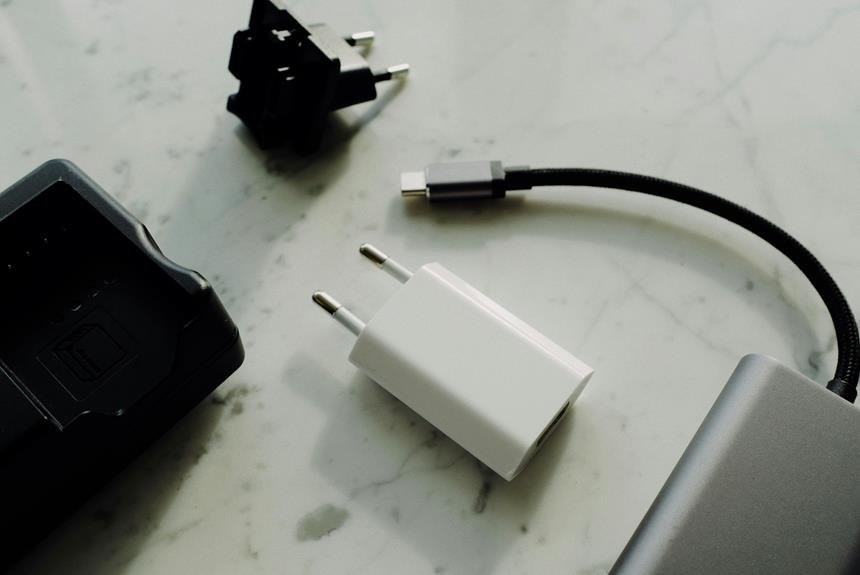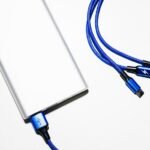Charging your Anker power bank typically takes between 4 to 10 hours, depending on the model and capacity. For example, the PowerCore Slim may complete charging in about 4 hours, while high-capacity models like the PowerCore+ 26800 can take up to 10 hours. Using a higher wattage charger and high-quality cables can shorten this time. Anker recommends a 5V/2A wall adapter for efficient charging effectiveness. Fast-charge technology like PowerIQ or Quick Charge can also hasten the process. To get the most efficient and safe charge, make sure you're using compatible chargers and cables. Discover more specific tips and factors next.
Factors Affecting Charging Time
Several factors can greatly impact the charging time of your Anker power bank, each playing an important role in determining how quickly it reaches full capacity. One primary consideration is the charging effectiveness and the power source you use. To maximize efficiency, make sure you're using a high-quality charger and cable compatible with your specific Anker model. A higher wattage power source will generally charge your power bank faster than a lower wattage one, so if you're using a weak adapter, you might experience slower charging times.
Another vital factor is the battery lifespan, which can degrade over time with frequent charging and discharging cycles. As the battery ages, its ability to hold and transfer charge efficiently diminishes, causing longer charging times. It's a good idea to monitor your charging frequency and avoid unnecessary charging when your power bank isn't fully depleted. This practice can help extend the battery lifespan, maintaining optimal charging speeds for longer periods.
Ultimately, understanding these factors allows you to make informed decisions, ensuring your Anker power bank charges swiftly and remains reliable. By optimizing charging effectiveness and being mindful of the battery's health, you can enjoy continuous, dependable power whenever you need it.
Anker Power Bank Models
Anker offers a diverse range of power bank models, each designed to meet specific needs and preferences, from compact options for everyday use to high-capacity units for extended trips. Whether you need a lightweight, pocket-sized device or a robust powerhouse, Anker's lineup guarantees you'll find something that suits your lifestyle.
For those who prioritize portability, models like the Anker PowerCore Slim or PowerCore 10000 are excellent choices. They're compact, yet they deliver efficient charging, ensuring your devices are powered up quickly. These models are perfect for casual users who need a reliable backup without the bulk.
If you require more substantial power output and longer battery life for multiple devices or extended usage patterns, consider the Anker PowerCore+ 26800 or the PowerCore III Elite. These high-capacity models are designed to handle demanding power needs, making them ideal for travelers or heavy device users.
Across the board, Anker's power banks are known for their charging efficiency, offering quick and reliable power delivery. The variety in power output and battery life across different models guarantees you can choose a power bank that fits seamlessly into your daily routine or adventurous excursions.
Battery Capacity and Charge Time
When considering an Anker power bank, you'll notice that battery capacity directly affects charge time. Larger capacities offer more extended usage but require longer periods to fully charge. However, with fast-charge technology, you can reduce the time needed to replenish your power bank, even with higher capacities.
Capacity Vs. Charge Time
How does the battery capacity of an Anker power bank impact its charge time? Simply put, larger capacity power banks take longer to charge than smaller ones. For instance, a 10,000mAh power bank will charge faster than a 20,000mAh model, given the same charging speed. When considering efficiency comparison, it's vital to note that higher capacity models may suffer from slightly reduced efficiency due to internal resistance. However, this variance is usually minimal.
Temperature also plays a significant role. Charging your power bank in extreme cold or heat can negatively impact its battery life and charging efficiency. Ideally, you should charge it in a moderate environment to maintain peak performance.
While larger capacity power banks provide more extended usage periods, they inevitably demand more time to recharge fully. If you're often on the go, balancing capacity and charge time becomes important. You might opt for a mid-range capacity to guarantee quicker recharge cycles without sacrificing too much power storage.
Fast-Charge Technology
Fast-charge technology significantly reduces the time it takes to recharge your power bank, irrespective of its capacity. This means you can spend more time on the move and less time connected to an outlet. When it comes to battery optimization, fast-charge technology enhances charging efficiency by delivering higher power levels in shorter time frames. This is vital for those who need their devices ready at a moment's notice.
Power bank compatibility is another critical factor. Not all power banks support fast-charge technology, so it's important to confirm that your Anker power bank and your devices are compatible. If both your power bank and your device support fast charging, you'll observe a notable decrease in charging time. This is especially beneficial for power banks with larger capacities, where traditional charging methods can be time-consuming.
When considering fast-charge technology, reflect on how it impacts your overall device charging routine. You'll benefit from quicker top-ups, allowing more freedom to use your devices without extended interruptions. Moreover, modern fast-charge systems are designed with safety in mind, reducing the risk of overheating and extending the lifespan of your power bank. This combination of speed and safety makes fast-charge technology a valuable feature for any power bank user.
Input Power and Charging Speed
When charging your Anker power bank, it is important to understand the voltage and amperage requirements to guarantee efficient charging. Different models support varying input levels, impacting how quickly they recharge. Additionally, some Anker power banks come with fast charging capabilities, allowing you to replenish the battery at a much faster rate.
Voltage and Amperage Requirements
To ensure peak performance and safety, understanding the voltage and amperage requirements for both input power and charging speed when using an Anker power bank is crucial. Grasping these requirements guarantees efficient charging and maximizes your device's power output. Typically, Anker power banks come with input specifications like 5V/2A or higher, depending on the model. Utilizing a charger that meets or surpasses these specifications will charge your power bank more effectively and securely.
Paying attention to these details also impacts your battery lifespan. Consistently using the recommended voltage and amperage can prolong your power bank's longevity. By aligning your charging habits with the manufacturer's guidelines, you avoid straining the battery, which can degrade its capacity over time.
Moreover, knowing the voltage and amperage requirements allows you to choose the appropriate chargers and cables. This not only aids in maintaining the power bank's health but also ensures quicker and more reliable charging sessions. Adhering to these specifications gives you the freedom to keep your devices powered up without unnecessary delays or risks, ultimately improving your overall experience with your Anker power bank.
Fast Charging Capabilities
Understanding the voltage and amperage requirements naturally leads to exploring the rapid charging capabilities of your Anker power bank, which can greatly enhance your device's charging efficiency and convenience. Rapid charging isn't just a buzzword; it's a feature that can greatly reduce the time you spend tethered to a power outlet. Anker models often support technologies like PowerIQ and VoltageBoost, which optimize the power flow to your connected device, guaranteeing that you get the quickest possible charge.
When considering input power, check if your Anker model supports higher wattage inputs, such as 18W or even 45W, through technologies like USB-C Power Delivery (PD). Higher input power means your power bank itself charges faster, freeing you up to use it sooner. This translates to less downtime and more freedom to move without worrying about battery levels.
Charging efficiency is another vital aspect. Rapid charging ensures minimal energy loss, meaning more of the electricity you're paying for goes directly into your device. Additionally, efficient charging can contribute to battery longevity by reducing the heat generated during the process. So, not only do you get a quicker charge, but your power bank also enjoys a longer lifespan.
Charging With Wall Adapters
Using a wall adapter is one of the most efficient methods to charge your Anker power bank quickly and reliably. When you're aiming for the best charging efficiency, using the appropriate wall adapter makes a significant difference. Not all wall adapters are made equal, and choosing one that's compatible with your power bank can maximize the charging speed and guarantee the longevity of your device.
First, make sure that the wall adapter you select is compatible with your Anker power bank. Here are some key points to keep in mind:
- Output Power: Check the output power of the wall adapter. Anker power banks typically require adapters with at least 5V/2A for standard charging.
- Brand Compatibility: While most third-party adapters will work, using Anker's own adapters can offer more reliable performance.
- Quality Assurance: Confirm the adapter is certified and meets safety standards to avoid any potential damage to your power bank.
- Cable Quality: The charging cable also plays a vital role. Using high-quality, preferably original Anker cables can further enhance charging efficiency.
Using Quick Charge Technology
When aiming for even faster charging times, leveraging Quick Charge technology can greatly boost the speed at which your Anker power bank recharges. Quick Charge is designed to reduce charging times significantly, making it an ideal choice for those who value both time and freedom. By utilizing this technology, you can enhance your charging efficiency, allowing your power bank to accumulate power at a much faster rate compared to standard methods.
To take full advantage of Quick Charge, you'll need a compatible power adapter and cable. These specialized accessories work in tandem to deliver higher power levels safely and effectively. The result is an impressive time-saving technique that gets your power bank back in action more swiftly. With Quick Charge, some Anker models can achieve up to 80% charge in just 35 minutes, far surpassing the performance of regular chargers.
For best results, make sure your Anker power bank supports Quick Charge. Investing in the right equipment not only maximizes charging efficiency but also ensures you're always ready to stay connected. This method offers a liberating solution for those who want to spend less time tethered to a power source and more time enjoying their mobile lifestyle.
USB-C Vs. Micro USB
Deciding between USB-C and Micro USB connectors can significantly impact the convenience and efficiency of charging your Anker power bank. USB-C is generally faster and more efficient. It often supports higher power delivery, which means your power bank charges quicker. On the other hand, Micro USB is more widespread and compatible with many existing devices, but it lacks the advanced capabilities of USB-C.
When considering charging efficiency, USB-C vs. Micro USB, here's what you need to understand:
- Speed: USB-C typically allows for quicker charging speeds compared to Micro USB.
- Reversibility: USB-C plugs can be inserted in either direction, making them easier to connect without orientation concerns.
- Durability: USB-C connectors are usually sturdier and more long-lasting compared to Micro USB.
- Compatibility Concerns: While USB-C is becoming the norm, many older devices still utilize Micro USB. It's crucial to evaluate what other devices you own to guarantee compatibility.
Ultimately, opting for USB-C can provide improved charging efficiency and future readiness, while Micro USB might be more practical if you already possess many compatible devices. Deliberate on these aspects thoughtfully to make the optimal choice for your requirements.
Tips for Faster Charging
Understanding the differences between USB-C and Micro USB is just one aspect; let's explore practical tips to ensure your Anker power bank charges as quickly as possible. First, always use a high-grade charger that aligns with the power bank's input specifications. A charger with inadequate power output can significantly reduce charging efficiency.
Next, consider using a USB-C charger if your power bank supports it, as it generally offers higher power output compared to Micro USB. This can notably cut down your charging time.
To further optimize charging, make sure your power bank and charger are kept in a cool environment. Overheating can not only slow down charging but also negatively impact battery health and longevity.
Here's a quick reference table for faster charging tips:
| Tip | Description | Benefit |
|---|---|---|
| Use High-Grade Charger | Matches power bank's input specs | Maximizes charging efficiency |
| Prefer USB-C | Higher power output than Micro USB | Faster charging times |
| Cool Environment | Avoid heat to maintain efficiency and health | Protects battery health |
Monitoring Charge Status
Keeping an eye on your Anker power bank's charge status is essential for maximizing its readiness for use when you need it most. Understanding the charge indicators on your device can greatly enhance your monitoring efficiency. Most Anker power banks come equipped with LED lights or digital displays that provide a clear view of the remaining battery capacity. These indicators help you track progress and offer a rough time estimation for when the charging process will be complete.
To effectively monitor your Anker power bank's charge status, consider the following points:
- LED Indicators: Typically, one LED light means 0-25% charged, two indicate 25-50%, three represent 50-75%, and four signal 75-100%.
- Digital Displays: Some models offer precise percentage readings, giving you a more accurate snapshot of the charge status.
- Charging Speed: Higher-capacity power banks might have slower charging times, so keep an eye on the indicators to manage your expectations.
- Regular Checks: Periodically check the charge status during charging to avoid overcharging and maintain peak battery health.
Frequently Asked Questions
Can I Use My Anker Power Bank While It's Charging?
Yes, you can use your Anker power bank while it's charging. However, for charging safety and to guarantee the battery lifespan, it's generally recommended to avoid doing so. This practice can generate excess heat, affecting performance.
Does the Type of Cable Affect Charging Time?
Yes, the type of cable affects charging time. Higher cable quality guarantees better power output and efficiency, reducing overall charging time. Using a low-quality cable can greatly hinder performance, leading to longer charging durations.
How Do I Know When My Anker Power Bank Is Fully Charged?
Oh, you mean you don't have a sixth sense for battery levels? Don't worry, just check the charging indicator. When the indicator light is steady, it's fully charged. This helps avoid overcharging risk and extends battery lifespan.
Is It Safe to Leave My Anker Power Bank Charging Overnight?
Leaving your Anker power bank charging overnight raises safety concerns. While modern designs minimize overcharging risks, consistent overnight charging can impact battery lifespan. It's safer to unplug once fully charged to maintain peak performance.
Can Extreme Temperatures Affect the Charging Efficiency of My Anker Power Bank?
Extreme temperatures can definitely impact the efficiency of your Anker power bank. Charging in too hot or too cold environments can reduce performance and potentially damage the battery. Keep it in a moderate, stable temperature for best results.



